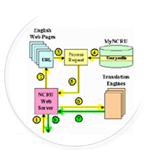
Computer scientists have been working since the 1960's on programs to translate from one language to another. Early funding for these efforts came from the U.S. government during the Cold War when the U.S. wanted an automated way to translate thousands of pages of Russian technical papers into English. After years of mediocre results from programs running on expensive mainframes, the output is now much better and the computers needed to run the software are much smaller cheaper. Today we have low-cost, commercially available computer systems and free websites that can translate from one language to another with useful quality. While the machine translations (MT) would never be mistaken for those performed by a good human translator, they are good enough to convey the basic meaning of the original text. This is what linguists are calling "gist" translations since the quality is good enough for the reader to get the gist (general idea) of the text. In the late 1990's I became intrigued with the idea of real-time machine language translation for web sites. In the spring of 2000 I sponsored a competitive MT "fly-off" evaluation in which two suppliers – SYSTRAN Software and Lernout & Hauspie – were invited to demonstrate the effectiveness of their systems in performing real-time, pure MT translations of sample pages from the NCRU web site. We tested four languages (French, German, Spanish, and Japanese), selected the SYSTRAN Enterprise Server, and started a customized implementation project for NCRU. In 2002 I published two papers describing my work in this area. And in another article in the Jan/Feb 2003 issue of the Technology Source I describe how I linked machine translation with web site personalization so that NCR associates who speak French, German, Italian, or Spanish could read information from NCRU in their native languages. By the end of 2002 I had published over 80,000 personalized copies of the MyNCRU newsletter and over 5,500 were automatically translated with no human intervention. You can read more about the "MyNCRU Personal Learning News" and see see samples of an original and translated newsletters. In a survey I conducted of 280 NCR employees who received one or more copies of the machine translated newsletters, I verified that people who have difficulty understanding English (the source language in our case) find the quality and usefulness of machine translations to be higher than do people who speak English fluently. While this may not seem surprising, it is important because in most large, multinational groups, people who are not proficient in reading and understanding the majority's language tend to be underrepresented in policy decisions about the importance of translation. At NCR, as in most U.S.-based multinational corporations, the official language is English and while this may be quite a satisfactory arrangement for the English-speakers who established the policy, it is a problem for many others. As the findings of my survey clearly illustrate, many NCR associates find the pure MT quite useful and a significant number (16% overall) told us directly that they would not read our newsletter if it were not translated. Losing this portion of our audience entirely and compromising the utility of our newsletter for an even larger group is simply not acceptable. For more information on the technology and its application in a multinational corporation, I invite you to take a look at these papers.
©D. Verne Morland, 2003-2019.
|